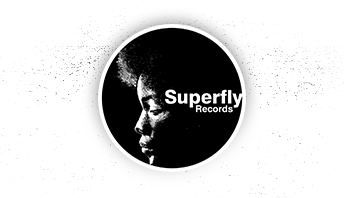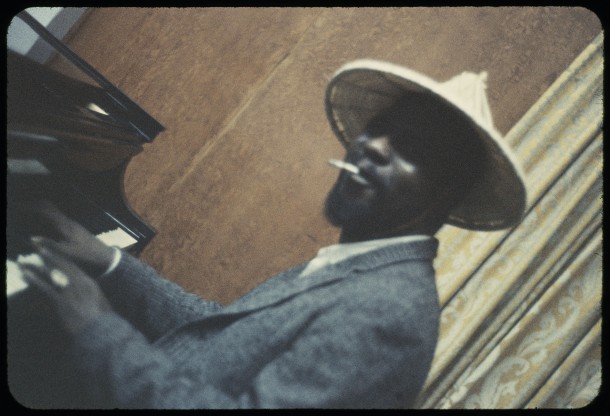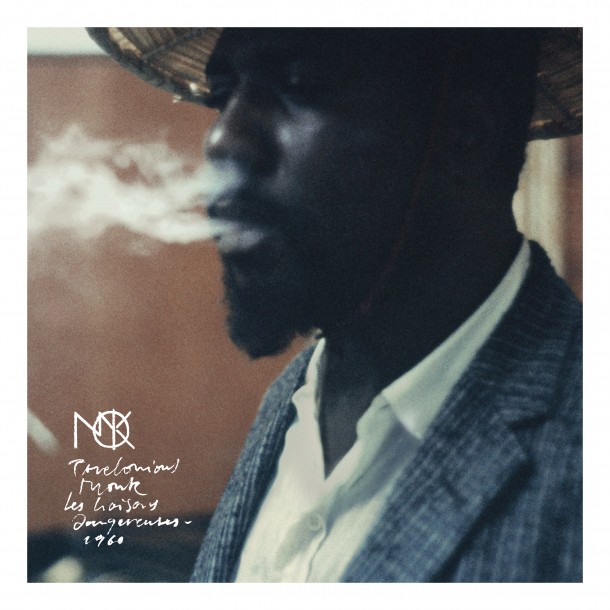



For the next Record Store Day, two small labels with very large ears (Sam Records and Saga) have teamed up to publish an unreleased Monk’s music studio session, the soundtrack of the movie Les Liaisons Dangereuses, in a beautiful box-set (2 Lps). More than dangerous, simply fabulous… In preview, the two deep diggers, Fred Thomas and François Lê Xuân, talk about this story.
photos: Courtesy of Arnaud Boubet / Private collection
How can someone possibly unearth an unreleased Monk studio session in 2017? Chance? Magic? Luck?
Luck and dedication! The most beautiful findings are often made by accident. Early in 2014 we got in touch with Laurent Guenoun, the custodian of Marcel Romano’s archives. In the Fifties, Marcel was the manager of saxophonist Barney Wilen, and we were looking for Wilen’s recordings that had never been released. No Barney, but Laurent announced that he did have some tapes that simply bore the words “Thelonious Monk.” We made an appointment to listen to these tapes shortly afterwards, imagining they might be copies of existing recordings or, at best, a concert, maybe the one Monk had given at Pleyel in 1954. A quick examination of boxes with titles of tunes by Monk or various scenes in Roger Vadim’s film allowed a glimmer of hope… could this be the actual recording session for “Les Liaisons Dangereuses”? Putting the first of those seven reels on the tape-machine was an emotional moment: some noise in the studio, and then we recognized the voice of Marcel. And then Monk! Monk moved on to the introduction for “Crepuscule with Nellie…” It was all there! The warm-ups, the discussions, the takes, moments of silence… We exchanged hardly a word while we listened to the tapes; we had a jubilant, almost unsettling feeling that we were in the same room as the session that had taken place fifty-five years earlier at Nola Studios in New York.
You are releasing it on the year of Monk’s hundredth anniversary…… Pure coincidence?
We won’t deny that Monk’s centennial celebration is a great opportunity to release such a project. But from the moment we found these tapes back in 2014 until now, we didn’t spare with our effort in the making of this project and all this time was necessary to create this record set.
This music was previously intended for the movie “Les Liaisons Dangereuses”. How did the pianist come to this session?
In the summer of 1958, Marcel Romano had convinced Roger Vadim to use Monk’s music for his new full-length movie, a modern rendition of Laclos’ book, “Les Liaisons dangereuses”. Romano was a serious Monk fan. They had met in Paris when Monk came for the first time on the Old Continent to feature at the third Salon du Jazz (Salle Pleyel, June 1954). In autumn 1958, he tried to have Monk to tour in Europe, and to record the soundtrack for Les Liaisons. in Paris. But Monk was facing difficult times in the US, including the loss of his NYC cabaret card, and could not come to Paris. Romano then flew to New York in June 1959 to record the soundtrack at Nola Penthouse Sound Studios.
He finally ended up not composing anything exclusive, original themes, for this soundtrack. How did he decide on the choice of the pieces he recorded?
That’s right. Monk was unable to compose for the movie merely due to a lack of time. When he came to NY, Romano had brought with him a detailed script containing precise timings for each scene that required music; he gave this to Monk who… asked to see the film. A screening of a working copy of the film — with sound that Vadim and Romano had added from records that were available — was organized for July 23.
He chose the repertoire based on his understanding of the story, and played around with the tempos in order to capture the character’s emotional state or circumstance, but he wrote no new music. On July 27, he simply recorded his usual repertoire: “Rhythm-a-Ning”, “Light Blue”, “Crepuscule with Nellie”, “Ba-Lue Bolivar Ba-Lues-Are”, “Well, You Needn’t”, and three versions of “Pannonica” (solo piano and ensemble). A piano solo blues improvisation and a gospel (“We’ll Understand It Better By and By”) were also recorded; they are both great interpretations that can be heard on the album.
Marcel Romano, as for other sessions that have become historical (“Ascenseur pour l’échafaud”), played an essential part in this story. Can you tell us more about this shadow character?
A lot more than these few lines would be necessary to pay fitting tribute to the work accomplished by Marcel Romano [1928-2007], to whom we owe the pleasure of being able to listen to this film music. After his first encounter with Monk in Paris in 1954, he would become an inescapable figure on the jazz scene in France: a concert producer and manager, a columnist for Jazz Hot, in charge of programming for the Club Saint-Germain… All his activities had only one aim: to share his passion for jazz and his love of musicians. From the end of 1957, when he played a part in setting up the recordings for the film Ascenseur pour l’échafaud, Marcel Romano had the privilege of being consulted by many filmmakers who loved jazz: following the example of Miles Davis and his recordings for Louis Malle, Art Blakey and his Jazz Messengers — booked to play a series of concerts at the Club Saint-Germain and the Olympia — would record the soundtrack for a film by director Edouard Molinaro. In the early 1960’s, Marcel took a leave of absence from the jazz world, but reappeared in the early 1970’s as a seller at the famous Champs-Elysées record store, Lido Musique.

There is also Barney Wilen in this session. Who had the idea to invite him into this quintet ?
French saxophonist Barney Wilen was Marcel Romano’s protégé since his first appearance in the Paris jazz scene in 1954. Since then he had been playing on numerous records including two soundtracks supervised by Romano (“Ascenseur pour l’échafaud” and “Un témoin dans la ville”). Barney was already in the US at the time as he had just made his American debut at Newport Jazz Festival. At Art Blakey’s request, Barney was to replace Hank Mobley when it was time for the Messengers to record the score of Liaisons Dangereuses. Marcel Romano proposed to include Barney as special guest in addition to Monk’s quartet, and it was a brilliant idea considering his performance during the recording session.
The official soundtrack for the movie was signed by Art Blakey on Fontana. What is finally the role of Monk’s music in this movie?
Monk’s music is predominant in the soundtrack of the movie; it is used as background music during the whole film. Blakey’s contributions were only used for what film people call “source music” (in this case, a party sequence and a nightclub sequence). These newly discovered tracks display the pianist at the height of his powers, but to conceive of this music as a film score may not be readily apparent. The tunes were nearly all part of Monk’s regular repertoire and together could have been released as another commercial LP.
You add alternate takes, including a “Light Blue” making of: do you think this long piece helps understand the spirit of Monk?
Yes, we believe that this sequence is a really fascinating moment of the recording session. It starts with Art Taylor, randomly playing a pattern, of the kind that percussionists play when checking the tuning of their drums. Monk hearing this drum figure immediately starts to play the intro of “Light Blue” on it. It takes a while for Art Taylor to get into the groove of the tune, but Monk doesn’t give up on him, even though he calls him names from time to time. This sequence demonstrates Monk’s creative genius, his patience and determination. It also allows the listener to feel the atmosphere of this recording session.
To date, this is the only known studio recording of this Monk composition.
You chose to release a limited edition on LP with many documents to describe the session and put it into perspective. How did you get access to all these pictures, including the magnificent portrait that serves as a cover for the box set?
Both Sam Records and Saga are labels that are trying to release records that appeal to the eye, and we’re putting a lot of effort in selecting and adjusting the documents reproduced in our releases. We managed to find people who had known Marcel Romano well. Among these people, some had kept photos and other documents. Arnaud Boubet from Paris Jazz Corner gathered a lot of photos including a number of color slides. It is thanks to him that this boxed-set is so well illustrated. We also would like to acknowledge the great job that Jérôme Witz, our graphic designer, has done with all these wonderful documents.
Can we expect more from you in the future?
Yes, indeed! But unfortunately nothing we can share at the moment.
Great records, just bought it for the recordstoreday. For Monk fans, check this Thelonious Monk ABC Book published in both english and french : http://www.lenkalente.com/product/abecedaire-thelonious-monk-de-jacques-ponzio
great to read !